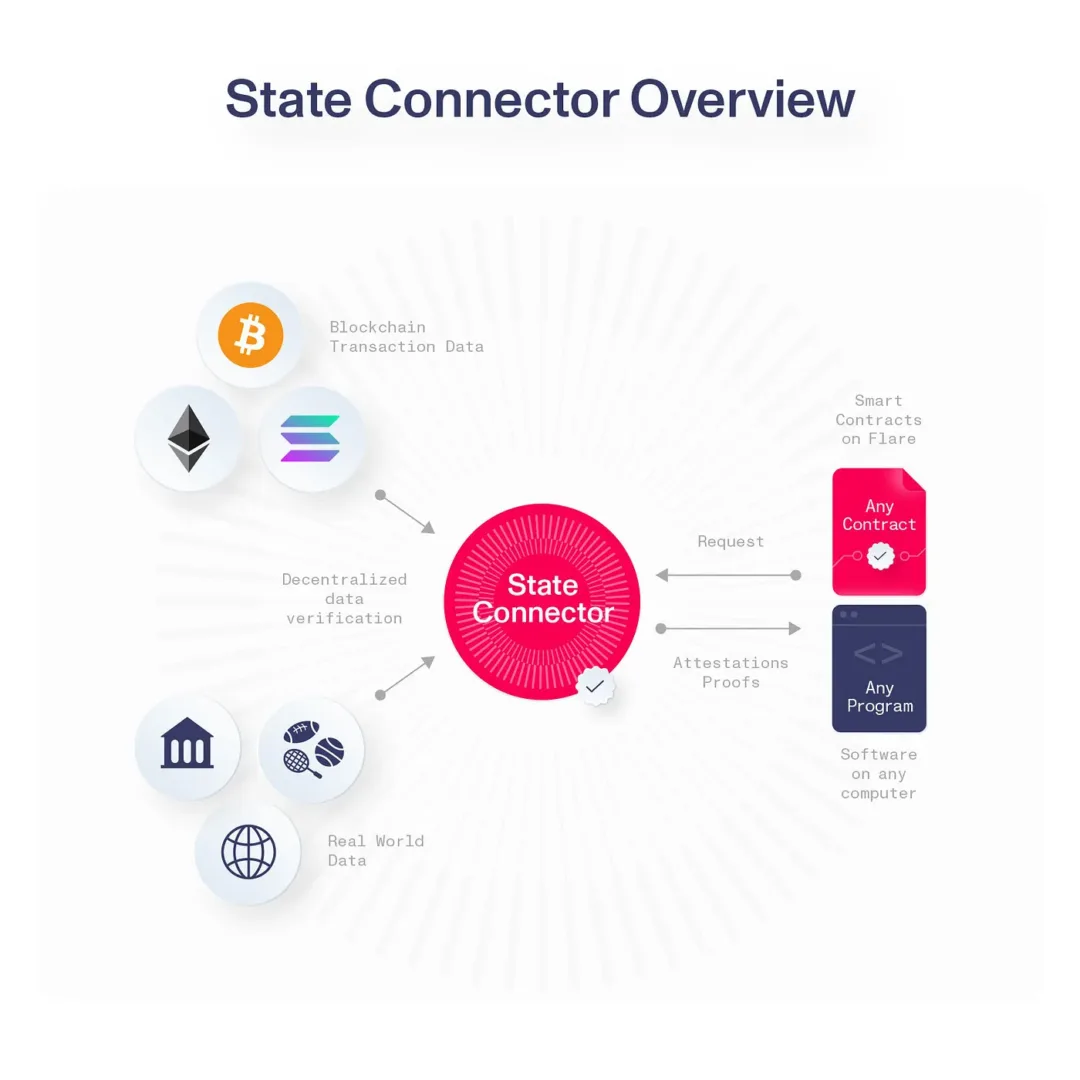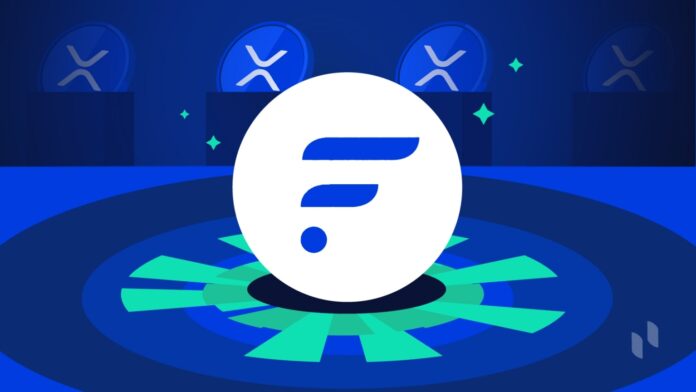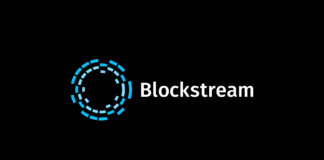In the ever-evolving landscape of blockchain technology, Flare Network stands out as a groundbreaking Layer 1 blockchain platform. This innovative system aims to bridge the gap between various blockchain ecosystems, offering a solution to the long-standing challenge of blockchain interoperability. Flare Network introduces a unique approach to tokenization and oracle systems, potentially reshaping the future of decentralized finance (DeFi) and blockchain scalability.
This comprehensive guide delves into the inner workings of Flare Network, exploring its core protocols and the technology that powers its ecosystem. We’ll examine the Flare Consensus Protocol, the concept of F-Assets, and the role of the FLR token in the network’s operations. Additionally, we’ll look at Flare’s native protocols, its Canary Network called Songbird, and the Flare Time Series Oracle (FTSO). By the end of this guide, readers will have a clear understanding of Flare Network’ potential applications, partnerships, and its place in the broader blockchain landscape.
Since it is a comprehensive document, it is going to be long. here is table of content
Table of Contents
What is Flare Network?
Flare Network operates as a Layer 1 blockchain that leverages the Ethereum Virtual Machine (EVM) It’s a distributed network designed to create bridges between different blockchain ecosystems, powered by its native cryptocurrency, FLR Flare stands out as the blockchain for data, aiming to expand the utility of blockchain technology
The primary goal of Flare Network is to promote interoperability and interconnectivity throughout the Web3 space It seeks to provide data as a public good, ensuring that information is not controlled by centralized entities but is available to all By offering developers decentralized access to high-integrity data from other chains and the internet, Flare enables the creation of decentralized applications (dApps) with new use cases and monetization models
Related Read: In Depth Analysis: Supra Oracles, An Emerging Cross Chain DEX and Oracle Network
Key Features
- EVM Compatibility: Flare is fully compatible with the Ethereum Virtual Machine, allowing developers to create a wide array of dApps, including marketplaces, games, and innovative financial tools
- Advanced Consensus Protocol: Flare utilizes Avalanche Snowman++, a cutting-edge Proof-of-Stake (PoS) consensus protocol designed for high scalability, robust security, and energy efficiency
- Native Oracle Systems: The network incorporates two essential protocols:
- Flare Time Series Oracle (FTSO): A decentralized oracle providing timely and accurate off-chain data to smart contracts
- State Connector: Enables consensus on information from external blockchains and the internet, offering improved security and flexibility compared to other oracle systems
- Interoperability Solutions: Flare has developed products like F-Assets and Layer Cake to facilitate cross-chain interactions and asset issuance
- Multiple Networks: Flare ecosystem includes four networks – Flare (main network), Songbird (canary network), Coston, and Coston2 (test networks) – each serving different purposes for users and developers
By combining these features, Flare Network aims to advance the development of blockchain use cases where data is crucial, such as DeFi, gaming, NFTs, and AI applications
The Evolution of Blockchain Interoperability
Challenges in Current Systems
The blockchain landscape has long grappled with the issue of interoperability. As the distributed ledger technology (DLT) ecosystem expanded, it gave rise to numerous chains operating in isolation, unable to communicate due to technological incompatibilities This fragmentation has posed significant challenges for the development of truly interconnected blockchain applications.
Current solutions to blockchain interoperability have their limitations. Centralized multi-sig bridges, while common, encourage higher centralization and are more susceptible to attacks, regulations, and censorship Light Client Relays, another approach, suffer from complex on-chain implementation, slow operation, and only approximate the security of a full node, making them vulnerable to attacks
Multi-chain systems like Cosmos and Polkadot have attempted to address interoperability issues but require chains to conform to their standards, essentially adopting their protocol and code to enable communication This approach limits true universal interoperability, as it doesn’t accommodate chains that cannot or choose not to modify their code.
Flare’s Innovative Approach
Flare Network emerges as a groundbreaking solution in the realm of blockchain interoperability. As a layer-1 blockchain leveraging the Ethereum Virtual Machine (EVM) framework, Flare aims to create a bridge between various blockchain ecosystems
At the heart of Flare’s approach is the State Connector protocol. This innovative system allows for the trustless reading of the state of transactions on any blockchain and can observe and prove the state of any open deterministic real-world data source in a decentralized manner The State Connector can relay this information to any contract on Flare or connected blockchain, circumventing the risks associated with current centralized oracle models
Flare’s approach doesn’t require integrated chains to modify their code, setting it apart from other interoperability solutions This flexibility allows for true cross-chain interoperability, enabling the transfer of information and value across the entire blockchain ecosystem
Core Protocols of Flare
Flare Time Series Oracle (FTSO)

The Flare Time Series Oracle (FTSO) serves as the “Beating Heart” of the Flare Network, providing essential data and rewards This decentralized oracle system addresses a critical challenge in blockchain technology: the inability of smart contracts to access external data directly The FTSO relies on independent data providers, known as Signal Providers or Oracles, to collect and deliver off-chain data to the network
One of the primary functions of the FTSO is to supply pricing data for supported cryptocurrencies in US dollar denomination This data is crucial for various network applications, particularly in decentralized finance (DeFi) The FTSO ensures the fairness and accuracy of this data through a weighted consensus mechanism
Functionality
The FTSO acquires off-chain time series data without relying on a centralized entity to bring the data on-chain. It relies on independent data providers, known as Signal Providers or Oracles, to collect and deliver off-chain data to the network. The first type of data the FTSO accepts is pricing data for supported cryptocurrencies in US dollar denomination.
The FTSO ensures data fairness and accuracy through a weighted consensus mechanism. Each data provider’s submission is weighted by its stake and any FLR delegated to it by Flare holders, reflecting the community’s trust in that particular provider.
Data Providers
Data providers, or Signal Providers, play a crucial role in the FTSO system. They retrieve information from external sources, such as centralized and decentralized exchanges. The FTSO then computes a final estimate from this data.
As of the current reward epoch, there are numerous registered data providers, each with varying amounts of vote power and performance metrics. For example, Bifrost Wallet has a vote power of 1,286,280,377 FLR (3.96% of total vote power), while EvolveFTSO has 999,988,383 FLR (3.08%).
Rewards System
The FTSO incentivizes good actors through a rewards system. Data providers that supply useful price pair information close to the final estimate are rewarded. These rewards are shared with the token holders that delegated to them.
Rewards are paid out in $FLR and can be claimed after the following rewards epoch has begun. The rewards claim process is manual, which users can do using the button on the Rewards page. Newly claimed rewards will not be added to voting power until the following delegation lock.
This system ensures a highly decentralized and rapidly updating data feed, where no single party controls the process.
State Connector

The State Connector is a revolutionary protocol designed to enable secure and trustless interoperability between Flare and other blockchains It allows Flare to reach consensus on the state of any blockchain without requiring changes to the underlying chain’s code or protocol
Key features of the State Connector include:
- Decentralized validation of external blockchain states
- Support for fast, decentralized, and insured bridging between smart contract chains
- Ability to power cross-chain composability and secure multi-chain solutions
The State Connector operates through a network of Attestation Providers (APs) that fetch and verify external data These APs respond to binary, objective queries about events on other blockchains, such as transaction confirmations The consensus process involves a commit-and-reveal mechanism to prevent collusion, with answers being accepted if more than 50% of providers agree
Both the FTSO and State Connector protocols contribute significantly to Flare’s goal of enhancing blockchain interoperability and expanding the utility of decentralized applications across multiple chains.
Flare’s Canary Network: Songbird

Songbird serves as Flare’s canary network, a crucial component in the Flare ecosystem. A canary network is an operational blockchain with a defined token supply that allows for testing new features under real-world conditions before their deployment on the main network. This approach differs from a testnet, which typically has an unlimited token supply.
Purpose
Songbird’s primary purpose is to act as a filtering mechanism for community-initiated Flare governance proposals. It plays a vital role in Flare’s governance system, serving as the lower house in a planned bicameral structure. This setup allows the community to submit and vote on proposals, which, if approved, may be considered by the Flare Foundation for inclusion on the main Flare network.
Features
Songbird operates on a quarterly governance cycle, with four proposal periods per year. During each period, users can submit candidate Flare Improvement Proposals (FIPs) and stake SGB tokens to support their preferred proposals. The proposal with the most stake at the end of the period becomes an FIP, provided it is validly formed. This staking mechanism also allows participants to accrue FTSO rewards, creating an additional incentive for engagement.
Relationship with Flare
Songbird’s role as a canary network is integral to Flare’s development and governance. It allows for real-world testing of new features and acts as a preliminary stage for governance proposals. This relationship ensures that only well-vetted and community-supported changes make their way to the main Flare network, enhancing the overall stability and effectiveness of the Flare ecosystem.
The Flare Consensus Protocol
The Flare Consensus Protocol (FCP) serves as the backbone of the Flare Network, introducing a novel approach to blockchain consensus. FCP is built upon the principles of Federated Byzantine Agreement (FBA), a consensus mechanism that diverges from traditional Proof-of-Work (PoW) or Proof-of-Stake (PoS) models
Federated Byzantine Agreement
FBA stands out as a unique form of Byzantine fault tolerance where each node maintains its own list of trusted nodes. Unlike PoW or PoS protocols, FBA doesn’t require nodes to invest stake or computing power In the FBA model, nodes form “quorum slices” – lists of other nodes they voluntarily choose to trust. When all nodes in a quorum slice agree on a result, it’s enough to convince the node of that result. If these quorum slices are correctly constructed, a global quorum emerges from these local decisions
FCP takes this concept further by implementing an asynchronous, ordered, and leaderless version of FBA This design aims to achieve fairness in transaction processing, making it exceedingly difficult for an attacker to influence the order of transactions within a set. The protocol also boasts fast finality, enhancing the network’s efficiency
Advantages over Proof-of-Stake
While Flare Network utilizes a Proof-of-Stake system similar to Ethereum, it enhances this concept with the advanced Avalanche Snowman++ consensus algorithm This protocol combines directed acyclic graphs (DAGs) and consensus checkpoints to achieve high security and scalability. The result is faster transaction finalization and the ability to handle a high volume of transactions simultaneously
Compared to traditional PoS systems, FCP offers several advantages:
- Energy Efficiency: FCP doesn’t require the extensive computational power often associated with PoS systems
- Decentralization: The FBA model allows for a more distributed decision-making process, potentially reducing the “rich get richer” effect seen in some PoS systems
- Security: FCP has undergone rigorous mathematical proofs of its Byzantine fault-tolerance, currently under peer review
F-Assets and Their Importance
F-Assets are wrapped versions of original tokens from other blockchains, referred to as underlying networks in Flare terminology. These assets bring smart contract functionality to tokens that currently lack this feature, enabling them to be used trustlessly with smart contracts on the Flare blockchain.
Definition
F-Assets are essentially synthetic assets that mirror the value of real-world assets, ensuring their price remains closely tied to the underlying asset. They are ERC20 tokens on the Flare/Songbird chain, requiring collateral for minting [35]. The collateral comes in two parts: native token collateral (FLR/SGB) at a minimum of 150% of the minted F-Asset’s value, and stablecoin collateral at a 1:1 ratio.
Use Cases
F-Assets unlock various possibilities for non-smart contract cryptocurrencies:
- Participation in DeFi: Holders can leverage F-Assets in decentralized finance opportunities, potentially generating additional yield.
- Cross-chain functionality: F-Assets facilitate easier and more secure transfer of assets to other blockchains.
- NFT market access: Previously excluded tokens can now participate in the booming NFT market.
- dApp development: Communities can now host and develop decentralized applications on the Flare network.
Benefits
F-Assets offer several advantages:
- Enhanced security: Backed by the network’s native token and stablecoins, F-Assets boast increased resistance to fraud and theft.
- Improved liquidity: F-Assets can be readily traded on decentralized exchanges, ensuring easy exchange for other assets.
- Seamless interoperability: Designed to move across different blockchains, F-Assets offer wider accessibility.
- Earning potential: F-Asset holders receive additional rewards in the form of $FLR tokens distributed from the network’s Cross-Chain Incentives Pool.
- Cost-effective solution: Using F-Assets is relatively affordable compared to traditional methods.
By enabling smart contract functionality for previously incompatible tokens, F-Assets have the potential to unlock a significant portion of the blockchain market’s total value, estimated at around USD 800.00 billion.
The FLR Token: Powering the Flare Ecosystem
The Flare token (FLR), formerly known as Spark, serves as the native cryptocurrency of the Flare ecosystem. As an EVM-compatible smart contract platform, Flare utilizes FLR to facilitate various network functions and interactions.
Token Utility
FLR plays a crucial role in the Flare Network’s operations:
- Transaction fees: Users pay network fees using FLR to prevent spam attacks.
- Staking: Token holders can stake FLR to validator nodes, contributing to network security through proof-of-stake consensus.
- Oracle delegation: FLR can be wrapped into WFLR for oracle delegation in the Flare Time Series Oracle (FTSO).
- Collateral: WFLR serves as collateral in various decentralized finance (DeFi) protocols.
- Governance: FLR holders can participate in network governance decisions.
Distribution
The initial FLR distribution occurred through an airdrop mechanism:
- 15% (4,278,738,206 FLR) was distributed during the Token Distribution Event on January 9, 2023.
- The remaining 85% (24,246,183,166 FLR) is being distributed over 36 monthly amounts to holders who wrap their FLR into WFLR.
Tokenomics
Flare’s tokenomics are designed to support broader adoption of web3 and create a balanced ecosystem:
- Total supply: 28,524,921,372 FLR
- Community allocation: 58.3% of the genesis supply
- Annual inflation: 10% in year 1, 7% in year 2, and 5% from year 3 onwards
- Inflation distribution: 70% to FTSO rewards, 20% to validator rewards, and 10% to the default Attestation Provider Set
To support ecosystem health, Flare announced a burn of 2.1 billion FLR tokens, representing over 2% of the total supply.
Use Cases and Potential Applications
DeFi
Flare Network’s integration of the Ethereum Virtual Machine with established smart contract standards has paved the way for a thriving decentralized finance (DeFi) ecosystem. Flare Finance, the first DeFi platform on the network, offers users various opportunities to earn additional revenue streams. These include participation in liquidity pools, yield farming, lending, and more.
The network’s DeFi ecosystem received a significant boost with the launch of a 510 million FLR DeFi emissions program, approved through community governance. This program aims to incentivize the provision of deep stablecoin, FLR, and ETH liquidity, supporting the growth of Flare’s DeFi ecosystem in anticipation of the launch of FAssets.
NFTs
Flare Network has also become a hub for innovative NFT projects. Block Bonez, a dynamic PFP NFT collection, minted out its entire collection of 10,000 base layer NFTs in under 12 hours. This collection allows holders to customize their NFTs with up to 5 different traits and earn $FLR rebates based on the rarity of their creations.
Another notable NFT project is the FOCUS NFT Passes, which enable users to receive a share of fees earned from validation on the Flare Network. With a limited supply of 600 NFT Passes divided into four rarities, these passes grant holders the right to claim delegation rewards.
Cross-Chain Interoperability
Flare Network’s integration with Polyhedra’s ZK Bridge has enhanced its cross-chain capabilities, allowing developers to build secure cross-chain applications. This collaboration leverages LayerZero’s interoperability while benefiting from the robust security of zero-knowledge proofs. The integration supports over 30 layer one (L1) and layer two (L2) networks, providing secure and efficient interoperability by verifying state transitions across chains.
Partnerships and Adoption
Notable Collaborations
Flare Network has forged significant partnerships to enhance its ecosystem. Google Cloud has joined as an infrastructure provider, acting as both a network validator and contributor to the Flare Time Series Oracle (FTSO). This collaboration supports Flare’s proof of stake consensus mechanism and contributes to its decentralized price oracle. Additionally, Flare has become part of the Google for Startups Cloud Program, offering developers access to financial and technical support.
Integration with Existing Platforms
Flare has integrated with LayerZero, a cross-chain messaging platform, enabling decentralized data access across 75 blockchains, including Ethereum and Solana. This integration allows users to utilize data from 50,000 dApps across various ecosystems. Furthermore, Flare’s collaboration with Stargate V2, an omnichain liquidity transport protocol, connects it to over 25 blockchain networks. This partnership leverages Stargate V2’s Hydra feature, facilitating the smooth transfer of USDC, USDT, and ETH to Flare.
Conclusion
Flare Network represents a significant leap forward in blockchain technology, aiming to solve the long-standing issue of interoperability. Its innovative approach, combining the Flare Consensus Protocol, F-Assets, and native oracle systems, has the potential to reshape the DeFi landscape. By enabling cross-chain communication and bringing smart contract functionality to previously incompatible tokens, Flare opens up new possibilities for developers and users alike.
As the blockchain industry continues to evolve, Flare’s success will depend on its ability to deliver on its promises and gain widespread adoption. The network’s focus on data as a public good and its commitment to creating a more interconnected Web3 ecosystem make it a project worth watching. With its unique features and ambitious goals, Flare Network is poised to make a lasting impact on the future of decentralized technology.
FAQs
How does the Flare Network operate?
Flare Network functions as an EVM-compatible smart contract platform, incorporating two native data acquisition protocols. It provides decentralized price and data feeds directly to decentralized applications (dApps) on its network, without the need for centralized data providers. Additionally, it enables the secure and trustless use of data from other blockchains and the internet within the Flare ecosystem.
What is the token distribution ratio of the Flare Network?
The Flare Network has set the distribution ratio at 1.0073 FLR tokens for every 1 XRP, distributing 15% of the total supply to the community.
How many FLR tokens will I receive?
Initially, you will receive 15% of the total FLR tokens you are eligible for, prior to the implementation of the Flare Improvement Proposal (FIP).
On what network does Flare operate?
Flare Network operates on a blockchain platform that supports smart contracts and decentralized applications (dApps) using the Proof-of-Stake (PoS) consensus mechanism and the Ethereum Virtual Machine (EVM).













